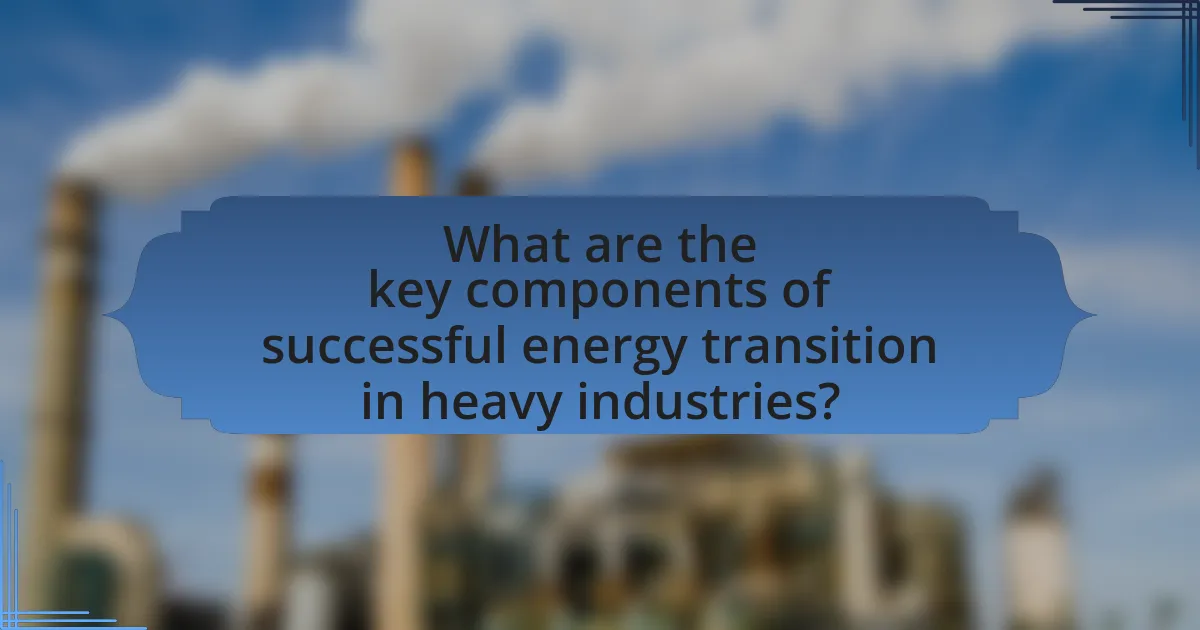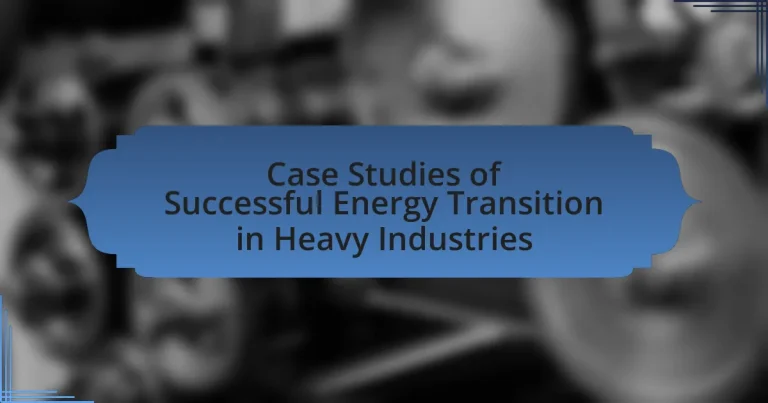The article focuses on case studies of successful energy transitions in heavy industries, highlighting companies such as ArcelorMittal, HeidelbergCement, and Norsk Hydro. It examines the strategies these industries have implemented, including carbon capture technologies, the use of alternative fuels, and the integration of renewable energy sources, to significantly reduce greenhouse gas emissions. The article also discusses the importance of energy transition for sustainability, operational efficiency, and compliance with regulations, while addressing the challenges and barriers faced during this process. Key metrics for measuring success, such as emissions reduction and energy efficiency improvements, are outlined, along with best practices and lessons learned that can guide future transitions in heavy industries.
What are Case Studies of Successful Energy Transition in Heavy Industries?

Case studies of successful energy transition in heavy industries include the transformation efforts by companies such as ArcelorMittal, which has implemented carbon capture and storage technologies to reduce emissions in steel production. Another example is the cement industry, where companies like HeidelbergCement have adopted alternative fuels and raw materials, achieving a significant reduction in carbon footprint. Additionally, the aluminum sector has seen success with Norsk Hydro’s use of renewable energy sources, which has led to a substantial decrease in greenhouse gas emissions. These cases demonstrate effective strategies and technologies that heavy industries can adopt to transition towards more sustainable energy practices.
How do these case studies illustrate the energy transition process?
These case studies illustrate the energy transition process by showcasing successful implementations of renewable energy technologies in heavy industries. For instance, one case study highlights a steel manufacturing plant that reduced its carbon emissions by 30% through the adoption of electric arc furnaces powered by renewable electricity. This shift not only decreased reliance on fossil fuels but also demonstrated the economic viability of transitioning to cleaner energy sources. Another example involves a cement company that integrated biomass as a fuel alternative, resulting in a significant reduction in greenhouse gas emissions and operational costs. These examples provide concrete evidence of how heavy industries can effectively transition towards sustainable energy practices while maintaining productivity and profitability.
What specific industries are highlighted in these case studies?
The specific industries highlighted in these case studies are steel, cement, and chemical manufacturing. These industries are known for their significant energy consumption and greenhouse gas emissions, making them critical targets for energy transition initiatives. The case studies demonstrate successful strategies implemented within these sectors to reduce carbon footprints and enhance sustainability practices.
What metrics are used to measure success in these transitions?
Metrics used to measure success in energy transitions in heavy industries include greenhouse gas emissions reduction, energy efficiency improvements, and cost savings. Greenhouse gas emissions reduction quantifies the decrease in carbon output, often measured in metric tons of CO2 equivalent, indicating the environmental impact of the transition. Energy efficiency improvements are assessed through metrics such as energy consumption per unit of production, reflecting how effectively energy is utilized. Cost savings are evaluated by comparing operational costs before and after the transition, demonstrating the financial viability of adopting new energy sources or technologies. These metrics collectively provide a comprehensive view of the effectiveness and sustainability of energy transitions in heavy industries.
Why is energy transition important for heavy industries?
Energy transition is important for heavy industries because it enables them to reduce greenhouse gas emissions and enhance sustainability. Heavy industries, such as steel and cement production, are significant contributors to global carbon emissions, accounting for approximately 20% of total emissions. Transitioning to renewable energy sources and adopting energy-efficient technologies can help these industries lower their carbon footprint, comply with increasingly stringent regulations, and meet the growing demand for sustainable products. Furthermore, energy transition can lead to cost savings through improved energy efficiency and reduced reliance on fossil fuels, ultimately fostering long-term economic viability.
What environmental impacts are addressed through energy transition?
Energy transition addresses several environmental impacts, primarily reducing greenhouse gas emissions, improving air quality, and conserving natural resources. By shifting from fossil fuels to renewable energy sources, such as wind, solar, and hydroelectric power, industries can significantly lower their carbon footprint. For instance, a study by the International Renewable Energy Agency (IRENA) indicates that transitioning to renewable energy could reduce global CO2 emissions by up to 70% by 2050. Additionally, energy transition helps decrease pollutants like sulfur dioxide and nitrogen oxides, which contribute to smog and respiratory issues, thereby enhancing public health. Furthermore, the adoption of energy-efficient technologies leads to a more sustainable use of resources, minimizing waste and promoting conservation.
How does energy transition affect operational efficiency?
Energy transition enhances operational efficiency by integrating renewable energy sources and optimizing energy consumption. This shift reduces reliance on fossil fuels, leading to lower energy costs and improved sustainability metrics. For instance, a study by the International Renewable Energy Agency (IRENA) found that companies adopting renewable energy solutions experienced a 10-30% reduction in energy costs, which directly contributes to enhanced operational efficiency. Additionally, the implementation of energy-efficient technologies during the transition can streamline processes and reduce waste, further boosting productivity and profitability in heavy industries.
What challenges do heavy industries face during energy transition?
Heavy industries face significant challenges during energy transition, primarily due to high capital costs, technological limitations, and regulatory pressures. The transition often requires substantial investment in new technologies and infrastructure, which can strain financial resources. For instance, the International Energy Agency reported that the steel industry alone would need to invest approximately $1.5 trillion by 2050 to achieve net-zero emissions. Additionally, many heavy industries rely on established processes that are not easily adaptable to new energy sources, creating technological hurdles. Regulatory frameworks can also impose strict timelines and compliance requirements, adding pressure to adapt quickly while maintaining operational efficiency.
What are the common barriers to implementing energy transition strategies?
Common barriers to implementing energy transition strategies include financial constraints, regulatory challenges, technological limitations, and resistance to change. Financial constraints often arise from the high upfront costs associated with renewable energy technologies and infrastructure upgrades, which can deter investment. Regulatory challenges may stem from outdated policies that do not support new energy solutions or create uncertainty for stakeholders. Technological limitations can hinder the adoption of innovative solutions, particularly in industries reliant on established processes. Lastly, resistance to change from employees and management can impede the transition, as stakeholders may be hesitant to adopt new practices or technologies. These barriers collectively hinder the progress of energy transition strategies in heavy industries.
How can industries overcome these challenges?
Industries can overcome challenges in energy transition by adopting innovative technologies, enhancing collaboration, and implementing effective policies. For instance, the integration of renewable energy sources, such as solar and wind, has been successfully demonstrated in heavy industries like steel manufacturing, where companies have reduced carbon emissions by up to 30% through the use of electric arc furnaces powered by renewable energy. Additionally, collaboration between industry stakeholders, governments, and research institutions fosters knowledge sharing and accelerates the development of sustainable practices. Effective policies, such as carbon pricing and incentives for green technology adoption, further drive industries toward successful energy transitions, as evidenced by the European Union’s Green Deal, which aims to make Europe climate-neutral by 2050.
What are the key components of successful energy transition in heavy industries?

The key components of successful energy transition in heavy industries include technological innovation, regulatory support, investment in renewable energy sources, and workforce training. Technological innovation enables the development of more efficient processes and equipment, reducing energy consumption and emissions. Regulatory support, such as government policies and incentives, encourages industries to adopt cleaner technologies. Investment in renewable energy sources, like solar and wind, provides sustainable alternatives to fossil fuels. Workforce training ensures that employees are equipped with the necessary skills to operate new technologies effectively. These components collectively facilitate a smoother transition towards sustainable energy practices in heavy industries.
What technologies are essential for energy transition?
Essential technologies for energy transition include renewable energy sources, energy storage systems, smart grid technology, and carbon capture and storage (CCS). Renewable energy sources, such as solar and wind, are crucial as they provide sustainable alternatives to fossil fuels, significantly reducing greenhouse gas emissions. Energy storage systems, like batteries, enable the efficient use of renewable energy by storing excess energy for later use, thus addressing intermittency issues. Smart grid technology enhances the efficiency and reliability of electricity distribution, allowing for better integration of renewable sources. Carbon capture and storage (CCS) technologies are vital for mitigating emissions from existing fossil fuel infrastructure by capturing CO2 and storing it underground, thereby facilitating a smoother transition to a low-carbon economy.
How do renewable energy sources contribute to these transitions?
Renewable energy sources significantly contribute to transitions in heavy industries by providing sustainable and low-carbon alternatives to traditional fossil fuels. These sources, such as solar, wind, and biomass, enable industries to reduce greenhouse gas emissions, thereby aligning with global climate goals. For instance, a study by the International Renewable Energy Agency (IRENA) highlights that transitioning to renewable energy can reduce emissions in the industrial sector by up to 70% by 2050. Additionally, renewable energy enhances energy security and price stability, as it relies on locally available resources, reducing dependence on imported fuels. This shift not only fosters innovation in energy technologies but also creates economic opportunities through job creation in the renewable sector.
What role does energy storage play in successful transitions?
Energy storage is crucial for successful transitions in heavy industries as it enables the integration of renewable energy sources, enhances grid stability, and optimizes energy usage. By storing excess energy generated during peak production times, industries can reduce reliance on fossil fuels and ensure a consistent energy supply during periods of low generation. For instance, a study by the International Renewable Energy Agency (IRENA) highlights that energy storage systems can increase the share of renewables in the energy mix, thereby facilitating a smoother transition to sustainable practices. This capability not only supports operational efficiency but also contributes to significant reductions in greenhouse gas emissions, aligning with global sustainability goals.
What strategies have proven effective in these case studies?
Effective strategies in the case studies of successful energy transition in heavy industries include the implementation of renewable energy sources, energy efficiency improvements, and the adoption of innovative technologies. For instance, companies that integrated solar and wind energy into their operations significantly reduced their carbon footprint and operational costs. Additionally, energy efficiency measures, such as upgrading machinery and optimizing processes, led to substantial energy savings, with some industries reporting reductions of up to 30% in energy consumption. Furthermore, the adoption of technologies like carbon capture and storage has proven effective in mitigating emissions while maintaining productivity. These strategies collectively demonstrate a successful pathway for heavy industries to transition towards sustainable energy practices.
How do companies engage stakeholders in the transition process?
Companies engage stakeholders in the transition process by implementing structured communication strategies, involving them in decision-making, and fostering collaboration. For instance, companies often hold workshops and forums to gather input from stakeholders, ensuring their perspectives are considered in the transition plans. Research indicates that effective stakeholder engagement can lead to increased support and smoother implementation of transition initiatives, as seen in case studies where companies like Siemens and Unilever actively involved local communities and employees in their sustainability efforts. This approach not only enhances transparency but also builds trust, which is crucial for successful transitions in heavy industries.
What best practices can be derived from these successful case studies?
Best practices derived from successful case studies in energy transition within heavy industries include the implementation of comprehensive energy audits, investment in renewable energy technologies, and fostering a culture of continuous improvement. Comprehensive energy audits allow organizations to identify inefficiencies and prioritize areas for improvement, leading to significant energy savings. Investment in renewable energy technologies, such as solar and wind, has been shown to reduce reliance on fossil fuels and lower greenhouse gas emissions, as evidenced by companies like Siemens and their commitment to achieving carbon neutrality by 2030. Additionally, fostering a culture of continuous improvement encourages innovation and employee engagement, which has been critical in companies like ArcelorMittal, where ongoing training and development have led to enhanced operational efficiencies and sustainability practices.
How can lessons from these case studies be applied to future energy transitions?

Lessons from case studies of successful energy transitions in heavy industries can be applied to future energy transitions by emphasizing the importance of stakeholder engagement, technological innovation, and policy support. Stakeholder engagement ensures that all parties, including employees, management, and local communities, are involved in the transition process, which fosters collaboration and reduces resistance. For instance, the transition of the steel industry in Sweden involved close collaboration with workers and local governments, leading to smoother implementation of new technologies.
Technological innovation is crucial, as demonstrated by the adoption of carbon capture and storage (CCS) in cement production, which significantly reduces emissions while maintaining productivity. This highlights the need for ongoing investment in research and development to create sustainable solutions.
Policy support, such as government incentives and regulations, plays a vital role in facilitating energy transitions. The successful implementation of renewable energy sources in the aluminum industry in Canada was largely due to favorable policies that encouraged investment in clean technologies. These elements—stakeholder engagement, technological innovation, and policy support—are essential for guiding future energy transitions effectively.
What insights can be gained from analyzing these successful transitions?
Analyzing successful transitions in heavy industries reveals key insights into effective strategies for energy transformation. These insights include the importance of stakeholder engagement, as companies that actively involve employees and local communities tend to experience smoother transitions. Additionally, the adoption of innovative technologies, such as renewable energy sources and energy-efficient processes, demonstrates significant reductions in carbon emissions and operational costs. For instance, a study by the International Energy Agency highlights that industries implementing renewable energy solutions can reduce greenhouse gas emissions by up to 70%. Furthermore, successful transitions often showcase the value of regulatory support and financial incentives, which facilitate investment in sustainable practices. Overall, these insights underscore the critical factors that contribute to effective energy transitions in heavy industries.
How can industries tailor strategies based on specific case studies?
Industries can tailor strategies based on specific case studies by analyzing successful implementations and extracting actionable insights relevant to their context. For instance, a case study on a heavy industry that successfully reduced carbon emissions through renewable energy integration can provide a framework for similar companies to adopt. By examining the specific technologies used, the challenges faced, and the outcomes achieved, industries can adapt these strategies to fit their operational needs and regulatory environments. This approach is validated by the fact that companies like Siemens have reported a 30% reduction in energy costs after implementing lessons learned from case studies in energy efficiency.
What are the implications for policy and regulation in energy transition?
The implications for policy and regulation in energy transition include the need for frameworks that support renewable energy adoption, emissions reductions, and technological innovation. Effective policies must incentivize investments in clean energy technologies, such as tax credits and subsidies, which have been shown to accelerate the transition, as evidenced by the rapid growth of solar and wind energy sectors in countries like Germany and the United States. Additionally, regulations must enforce stricter emissions standards to drive industries towards sustainable practices, as seen in the European Union’s Green Deal, which aims for carbon neutrality by 2050. These policy measures are crucial for aligning economic activities with climate goals and ensuring a just transition for affected workers and communities.
What practical steps can industries take to initiate their energy transition?
Industries can initiate their energy transition by conducting a comprehensive energy audit to identify current energy consumption patterns and inefficiencies. This step allows industries to pinpoint areas for improvement and prioritize energy-saving measures. Following the audit, industries should invest in renewable energy sources, such as solar or wind, to reduce reliance on fossil fuels. For instance, companies like Siemens have successfully integrated renewable energy into their operations, resulting in significant reductions in carbon emissions. Additionally, industries can implement energy management systems to monitor and optimize energy use continuously. According to the International Energy Agency, adopting such systems can lead to energy savings of 10-20%. Finally, engaging employees through training and awareness programs fosters a culture of sustainability, ensuring that energy transition efforts are supported at all levels of the organization.
What resources are available for companies looking to transition?
Companies looking to transition can access a variety of resources, including government grants, industry-specific guidelines, and consulting services. Government grants, such as those offered by the U.S. Department of Energy, provide financial support for projects aimed at reducing energy consumption and emissions. Industry-specific guidelines, like those from the International Energy Agency, offer best practices for implementing energy-efficient technologies. Additionally, consulting services from firms specializing in sustainability can help companies develop tailored transition strategies, leveraging expertise in energy management and regulatory compliance.
How can companies measure their progress in energy transition?
Companies can measure their progress in energy transition by utilizing key performance indicators (KPIs) that track energy consumption, emissions reductions, and the integration of renewable energy sources. These KPIs can include metrics such as the percentage of energy derived from renewable sources, reductions in greenhouse gas emissions compared to baseline levels, and improvements in energy efficiency across operations. For instance, a study by the International Energy Agency indicates that companies that set specific, measurable targets for renewable energy adoption and emissions reductions are more likely to achieve significant progress in their energy transition efforts.




